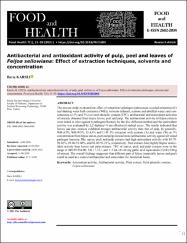Antibacterial and antioxidant activity of pulp, peel and leaves of Feijoa sellowiana: Effect of extraction techniques, solvents and concentration
Citation
Karslı, B. (2021). Antibacterial and antioxidant activity of pulp, peel and leaves of Feijoa sellowiana: Effect of extraction techniques, solvents and concentration. Food and Health, 7(1), 21-30. https://doi.org/10.3153/FH21003Abstract
The present study evaluated the effect of extraction techniques (ultrasound-assisted extraction (U)
and shaking water bath extraction (WB)), solvents (ethanol, acetone and distilled water) and concentration (2.5% and 5%) on total phenolic content (TPC), antibacterial and antioxidant activities
of extracts obtained from feijoa leaves, peel and pulp. The antibacterial activity of feijoa extracts
were tested in vitro against 6 pathogens bacteria by the disc diffusion method and the antioxidant
activity was evaluated by 2,2 diphenyl-1-picrylhydrazyl radical assay. The results indicated that
leaves and peel extracts exhibited stronger antibacterial activity than that of pulp. In generally,
WB-A5%, WB-W5%, U-A5% and U-W 5% extracted with acetone (A) and water (W) at 5%
concentration from feijoa leaves, peel and pulp showed more antibacterial activity against all tested
pathogen bacteria. The leaves, peel, and pulp extracts had high antioxidant activity with 85.78-
90.82%, 89.86-91.60%, and 81.49-91.31%, respectively. Peel extracts had slightly higher antioxidant activity than leaves and pulp extracts. TPC of leaves, peel, and pulp extracts were in the
range of 488.99-554.00, 349.17-517, and 115.64-345.46 mg gallic acid equivalents (GAE)/100 g
of extract. The overall findings suggested that different part of feijoa (especially leaves and peel)
could be used as a natural antibacterial and antioxidant for functional foods.


















